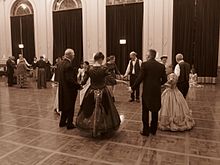
A country dance is any of a very large number of social dances of a type that originated in the British Isles; it is the repeated execution of a predefined sequence of figures, carefully designed to fit a fixed length of music, performed by a group of people, usually in couples, in one or more sets. The figures involve interaction with your partner and/or with other dancers, usually with a progression so that you dance with everyone in your set. It is common in modern times to have a "caller" who teaches the dance and then calls the figures as you dance. Country dances are done in many different styles.
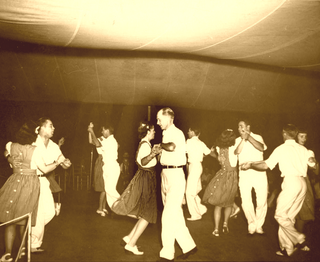
A square dance is a dance for four couples, or eight dancers in total, arranged in a square, with one couple on each side, facing the middle of the square. Square dances are part of a broad spectrum of dances known by various names: country dances, traditional dances, folk dances, barn dances, ceilidh dances, contra dances, Playford dances, etc. These dances appear in over 100 different formations, of which the Square and the Longways Set are by far the most popular formations.
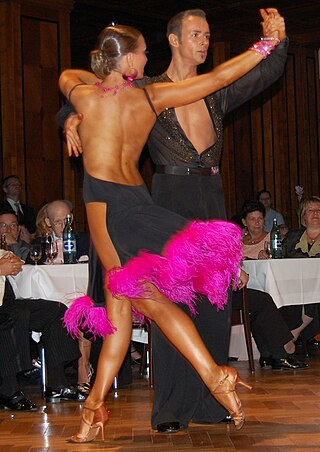
Partner dances are dances whose basic choreography involves coordinated dancing of two partners, as opposed to individuals dancing alone or individually in a non-coordinated manner, and as opposed to groups of people dancing simultaneously in a coordinated manner.
A solo dance is a dance done by an individual dancing alone, as opposed to couples dancing together but independently of others dancing at the same time, if any, and as opposed to groups of people dancing simultaneously in a coordinated manner. Solo dancers are usually the best dancers in a group or dance school. Most solo dancers start after about 6–7 years of dance or sooner. Most soloists are company kids of their dance school. They are usually in more than one dance.
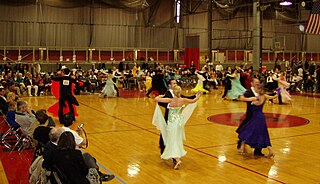
Dancesport is competitive ballroom dancing, as contrasted to social or exhibition dancing. In the case of Para dancesport, at least one of the dancers is in a wheelchair.
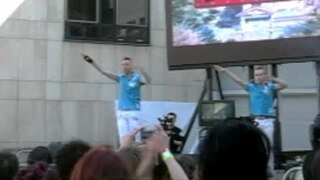
Para Para is a synchronized dance that originated in Japan. Unlike most club dancing and rave dancing, there are specific synchronized movements for each song much like line dancing. Para Para has existed since the early 1980s when European countries started selling Italo disco and Euro disco, and in the mid-to late 1970s, new wave and synthpop music in Japan. However, it did not achieve much popularity outside Japan until the late 1990s.
Zeibekiko is a Greek folk dance.
This is an alphabetical index of articles related to dance.
Bemani, stylized as BEMANI, is Konami's music video game division. Originally named the Games & Music Division (G.M.D.), it changed its name in honor of its first and most successful game, Beatmania, and expanded into other music-based games, most notably rhythm games such as Dance Dance Revolution, GuitarFreaks, and DrumMania.

Eurobeat refers to two styles of dance music that originated in Europe: one is a British variant of Italian Eurodisco-influenced dance-pop, and the other is a hi-NRG-driven form of Italo disco. Both forms were developed in the 1980s.

Kochari is a folk dance originating in the Armenian Highlands. It is performed today by Armenians, while variants are performed by Assyrians, Azerbaijanis, Kurds, and Pontic Greeks. It is a form of circle dance.

Nagas are various ethnic groups native to northeastern India and northwestern Myanmar. The groups have similar cultures and traditions, and form the majority of population in the Indian state of Nagaland and Naga Self-Administered Zone of Myanmar (Burma); with significant populations in Manipur, Arunachal Pradesh and Assam in India; Sagaing Region and Kachin State in Myanmar.
Alliance of Round, Traditional and Square-Dance, Inc. (ARTS-Dance) is an association to promote round, square, line, and other forms of traditional and folk dance. It is a non-profit/charitable foundation under the U.S. Internal Revenue Service section 501(c)(3) incorporated in North Carolina in 2003 with main address in San Diego, California. It used to be known as ARTS Alliance.

"King Kong" is a single released by the eurodance group E-Rotic in 2001. In 2005 was covered by J-Pop girl group Hinoi Team, and again in 2006 by the Germany-based J-pop group Shanadoo.

City of Dreams is a casino resort in Cotai, Macau, SAR of People's Republic of China. Built, owned and managed by Melco Resorts & Entertainment, the resort, also known as CoD or CoD Macau, opened on 1 June 2009. Described as a "mega-casino" by The Guardian, in 2020 City of Dreams was the third-largest casino in the world. In total the property comprises three separate casinos, four hotels, five hotel towers, around 2,270 total hotel rooms, around 30 restaurants and bars, and 175,000 square feet (16,300 m2) of retail space.

CALLERLAB is the international association of square dance callers, and is the largest square dance association in the United States. CALLERLAB provides guidance and education, certifying caller coaches, maintaining standardized lists of calls and definitions, and generally promoting the square dance activity. After some initial work started in 1971, it was officially established in 1974 by several members of the Square Dance Hall of Fame. Callerlab makes it so people can dance anywhere in the world with uniform dance calls.

The Federal University of Pará is one of the three public universities maintained by the Brazilian federal government in the state of Pará. It was ranked as the 15th largest Brazilian university in a 2011 academic ranking by the number of enrollments. The university has over 60,000 students enrolled in its courses, which are offered across its many campuses in the cities of Belém, Abaetetuba, Altamira, Ananindeua, Bragança, Castanhal, Cametá, Capanema, Breves, Tucuruí and Soure. Among UFPA research teams, there are many nationally recognized groups, particularly in the fields of genetics, parasitology, tropical diseases and geosciences. The Federal University of Pará is the largest institution in the North region of Brazil by enrollment and is a reference in the areas of Biomedical Sciences and Biology research, this last one mainly because of the Amazon Rainforest.

Tsilhqotʼin Nation v British Columbia is a landmark decision of the Supreme Court of Canada that established Aboriginal land title for the Tsilhqotʼin First Nation, with larger effects. As a result of the landmark decision, provinces cannot unilaterally claim a right to engage in clearcut logging on lands protected by Aboriginal title; they must engage in meaningful consultation with the title holder before they proceed. Although the Aboriginal title holder does not have to consent to the activity, meaningful consultation is required before infringement of the right can take place.


